Spring Conservation and Wildlife Update
As we reach the end of spring across Warwickshire’s Country Parks, we’re taking a look back at some of the seasonal highlights from our hardworking ranger teams in the north and south of the county.
With wildlife sightings, habitat restoration, species monitoring and more, here’s what’s been going on over the past few months.
Wildlife recording at Ryton Pools

Dusky Clearwing
Ryton Pools Country Park has officially recorded its 3000th species! The honour went to a tiny micro-moth, Narycia duplicella, discovered by Ranger George while searching for Pine Ladybirds. This incredible figure reflects years of careful site management and recording work, a collaboration between our ranger team and local experts and volunteers. From beetles and bees to butterflies and birds, the site now supports regionally and nationally important species across a wide range of habitats. Highlights include all 14 species of bumblebee found in Warwickshire, rare spiders, and priority butterfly species like the Wood White and Dark Green Fritillary. It’s a shining example of the positive impact of looking after our precious green spaces.
Newt news from Ryton’s ponds

Great Crested Newt
It has been our pleasure to partner with RSK Biocensus this spring to host Great Crested Newt survey training. Surveys have revealed individuals in unexpected ponds, including the Feeder Pool, which was previously considered unsuitable. Recent habitat enhancements, such as the installation of nearly 400 metres of coir rolls and aquatic planting (thanks to our partnership with Warwickshire Wildlife Trust’s Dunsmore Living Landscape team), appear to be creating ideal conditions for this protected species. The discovery of young newts (efts) during training surveys is an especially encouraging sign. This work will help shape our pond management going forward – and we hope to continue the partnership with RSK in future years.
Busy bees at Ryton Pools
Eight new bee species have been found at Ryton Pools so far in 2025, bringing the site total to 110 species. The presence of these new species tells us a great deal about how our management of the site is progressing for a few key habitats.
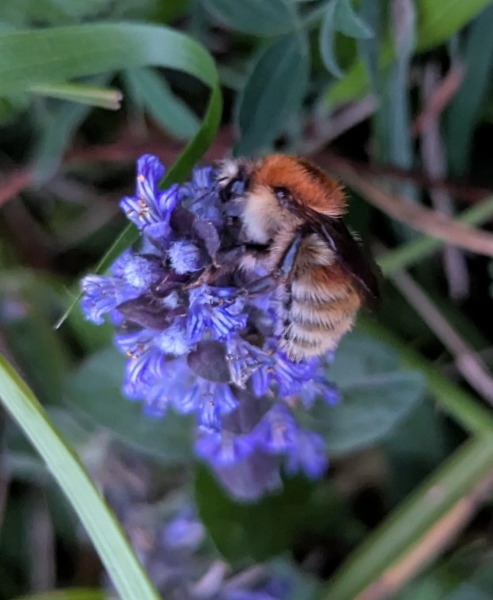
Brown-banded Carder Bee
Firstly, many of these species are strongly associated with sandy soils and heathland habitats - which are uncommon across Warwickshire. Last winter, the ranger team worked to expose more of this vital sandy soil by clearing back encroaching scrub from slopes and performing soil inversions on the orchid bank. Four of the sand-loving newcomers were found on these recently cleared areas - meaning the hard work has already provided more valuable nesting space for these scarce species.
Another two of the new bees are known to thrive in open, flower-rich meadows like our two biodiversity offsetting meadows - indicating continued improvement there as well. The discovery of a queen Brown-Banded Carder Bee (Bombus humilis) in particular was met with much celebration as it is one of the UK’s rarest bumblebees, and it was the only Warwickshire bumblebee missing from the site list. The ranger team will be keeping a lookout for workers and males as summer progresses.
Orchid season blossoms across the parks

Southern Marsh Orchid
We’re delighted to have spotted a recent flurry of orchids popping up at our parks. At Barn Meadow in Kingsbury Water Park, over a hundred spikes of Southern Marsh Orchid have been recorded – it’s fantastic to see them expanding their range across the field in this beautiful display.
Southern Marsh Orchids have also made a strong appearance at Ryton Pools Country Park, with numbers slightly up on last year thanks to careful winter habitat management.
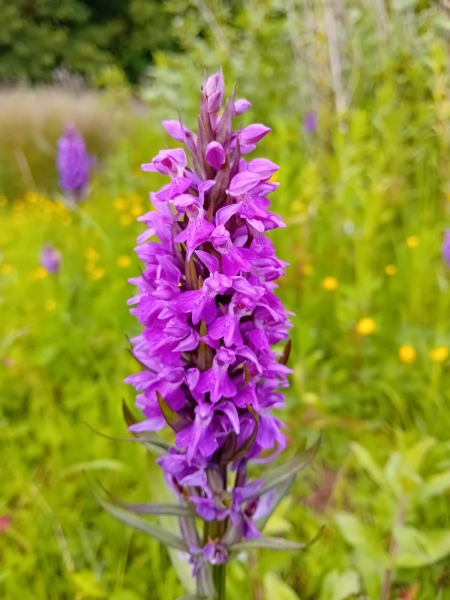
Pyramidal Orchid
This early orchid activity marks the beginning of the flowering season across our sites. Over the coming weeks, visitors can expect to see Bee Orchids, Common Spotted Orchids, Pyramidal Orchids, and Broad-leaved Helleborines, each bringing its own charm and supporting a wide variety of pollinators. With careful site management and ongoing monitoring, our parks continue to provide vital habitats for these iconic wildflowers to thrive.
Special sightings at Kingsbury Water Park
At Kingsbury Water Park, a family of Oystercatchers with a chick has been spotted in our nature reserve — a wonderful sign that our habitat work is paying off.
Back in February, Rangers Courtenay and Nelson spent time on the island at the reserve cutting back willow trees and clearing brambles to create a more suitable breeding site for water birds. Following on from this, it’s rewarding to see these Oystercatchers have returned to site and bred successfully for another year.
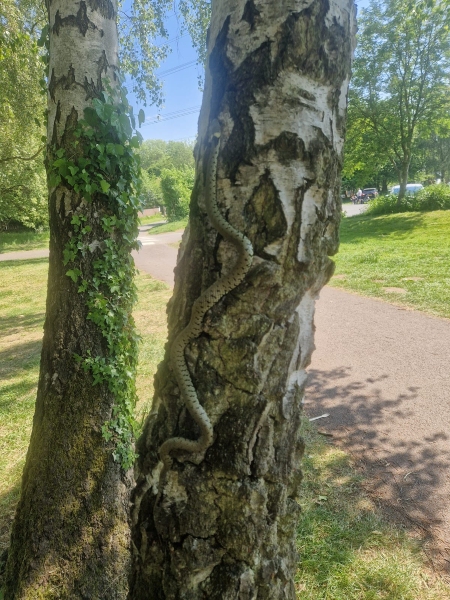
Grass snake climbing a tree
Visitors and Ranger Tom were also recently treated to another rare spectacle – a grass snake climbing a tree near the railway station! Although grass snakes are a regular (and welcome) presence at the park, they’re more commonly spotted swimming across the lakes. Seeing one making its way up a tree was a first for our team and a fantastic example of the unexpected moments nature can provide.
Battling invasive species
Also at Kingsbury Water Park, our volunteers and rangers have been busy tackling Himalayan Balsam along the wetter areas of the parks. While some areas can be managed mechanically, much of the effort now involves manual removal in harder-to-reach spots. Originally introduced as a garden plant in the 1800s, Himalayan Balsam is now a widespread invasive species that outcompetes native flora and alters the habitats it takes over. Keeping it in check is a crucial part of maintaining the health of our wetland and riverside environments.
Winter work rewarded with swathes of wildflowers at Stockton Cutting
-
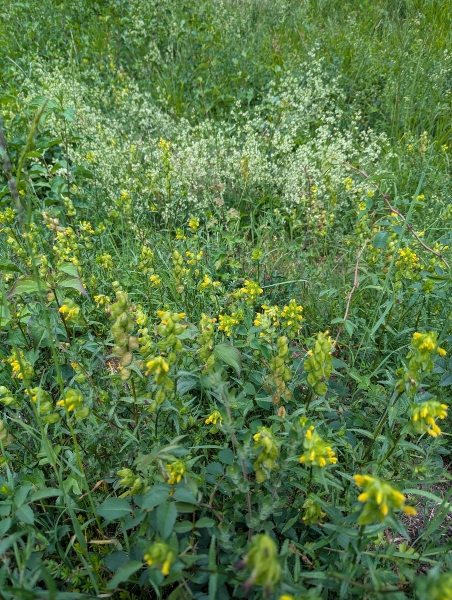
Wildflowers
-

Common Spotted Orchid
-
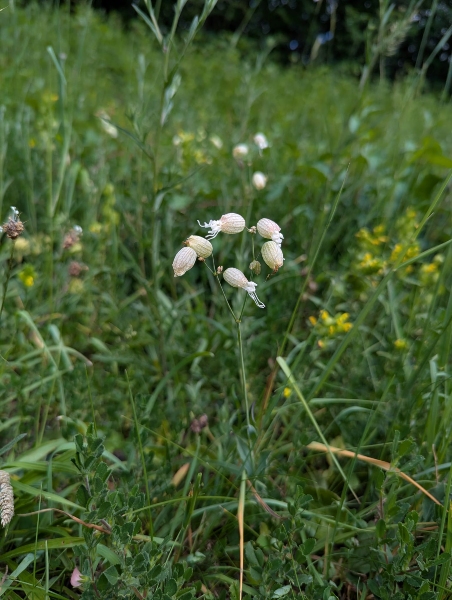
Bladder Companion
Following our winter work at Stockton Cutting, the areas we cleared are now awash with wildflowers! Yellow Rattle and Hedge Bedstraw (photos above) can be spotted along the main track, with plenty of patches of Bladder Campion and Restharrow too. Also tucked into the sward are three orchids: Common Spotter Orchid, Common Twayblade, and Greater Butterfly Orchid. With lots of butterflies now fluttering over the flowers, including Marbled Whites and Small Blues, this is an excellent early indication of the success of this project.
Things to look out for
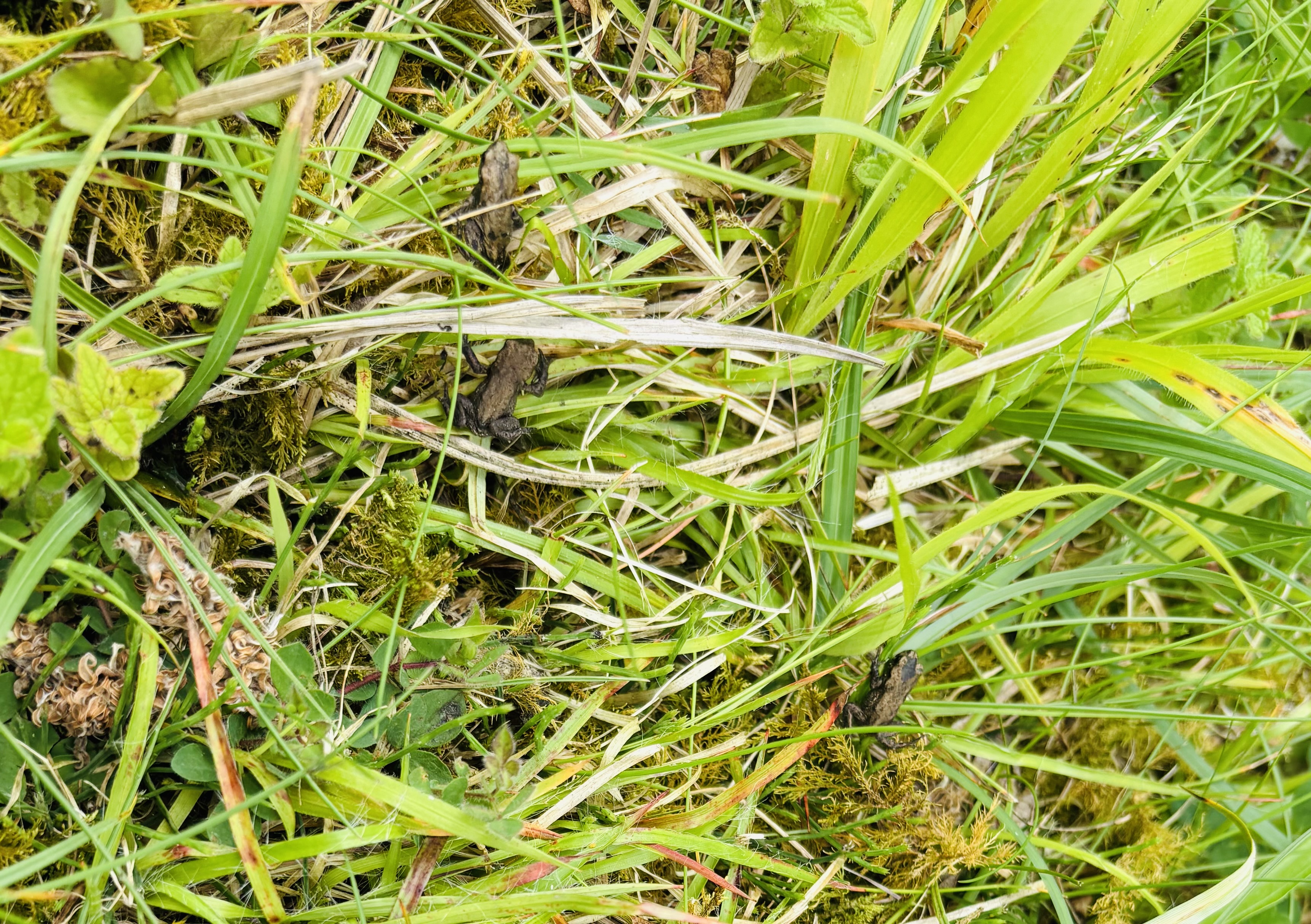
Toadlets at Ryton Pools
As well as the lovely flora and fauna outlined above, the summer months are also an excellent time to look out for butterflies, moths and dragonflies all of which thrive in the warmer conditions provided on halcyon summer days. The flowering season for some of our plants also continues into August and beyond: their displays may be more muted later in the season but are beautiful, nonetheless. All our avian summer visitors have now returned, too, so listen out for the screaming cries of Swifts and Swallows over summer meadows or water as they catch their insect prey before returning south in the autumn. With trees in full leaf, it’s also worth taking time to indulge in a spot of forest bathing, taking in the Psithurism of the wooded landscape (the sound of the leaves in the trees). Come and pay us a visit to see for yourself – and be sure to let us know what you find by following us on social media or emailing parksphotography@warwickshire.gov.uk.



